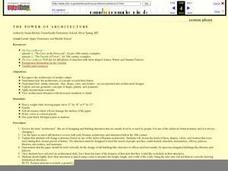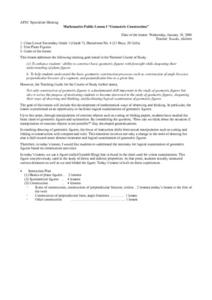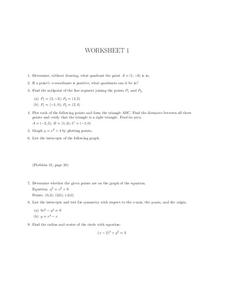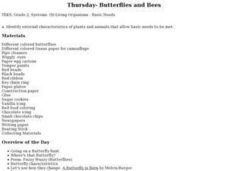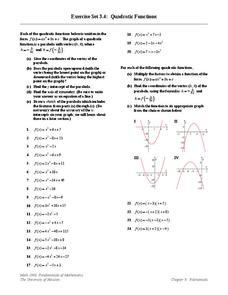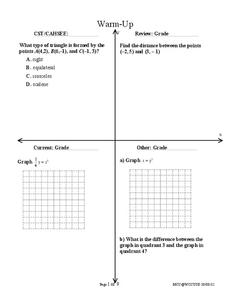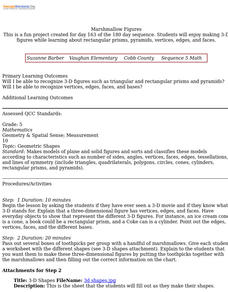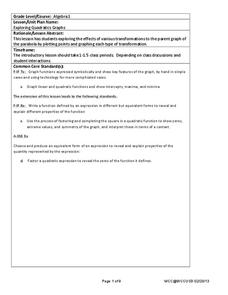Curated OER
Reflections
Students investigate the concept of reflectons. They investigate how an image has a reflection that is symmetrical. They also choose household objects in order to have real life application for finding lines of symmetry.
Curated OER
Geometry in Tessellations
Young scholars examine tessellations and their geometric properties. Students explore the concept of tessellations and lines, planes, angles, and polygons. Young scholars experiment with the area and perimeter of polygons. Students...
Curated OER
Compound Locus
Students investigate circles and compound locus. In this geometry lesson, students identify the distance from a point to a line. They use Cabri software to create lines and circles.
Curated OER
T H E P O W E R O F A R C H I T E C T U R E
Young scholars arecognize the architecture of another culture, how the architecture of a people records their history, explore artistic elements, explore and use geometric concepts of shape, pattern, and symmetry.
Curated OER
Slope Right Up
Students use triangles to find the length and slope of each side. After connecting the vertices, they add points based on their specific instructions. They use the Pythagorean Theorem to complete a worksheet to end the lesson.
Curated OER
Graphs of Quadratic Functions Section 11.6
In this graphing worksheet, learners graph quadratic functions. They identify the maximum and minimum value of the function, determine the line of symmetry, and locate the vertex. Coordinate planes are provided for each function. There...
Curated OER
Radial Design Mandala
Students design original radial art designs.In this radial design instructional activity, students use compasses and a nature inspired idea to create radial art. Students understand the use of symmetry, balance and design shapes in...
Curated OER
Geometric Construction
Seventh graders investigate some concepts associated with geometric shapes. They study the bisector segment and the perpendicular line to a given line. Students conduct analysis with the goal of deepening observation and deduction...
Curated OER
Worksheet 1, Coordinate Graphing
In this algebra worksheet, learners determine the quadrant a given point is in. They find the midpoints of two line segments. Students plot points to form a triangle and find the distance between points. Learners find the area of the...
Curated OER
Biology: Butterfly Activities
Second graders examine various types of butterflies and insects around their school. They identify differences between beetles and butterflies. Students examine books about butterflies, complete symmetry drawings, and make ladybug key...
Curated OER
Keeping Us in Stitches Activity: Whole Cloth Quilt Design
Students examine how decorative motifs are adapted to other types of objects by craftsmen and artists. They examine photos on the Illinois State Museum website, discuss design elements, adapt a motif to a line drawing, and transfer a...
EngageNY
The Definition of a Parabola
Put together the pieces and model a parabola. Learners work through several examples to develop an understanding of a parabola graphically and algebraically.
Virginia Department of Education
Properties of Quadrilaterals
What type of quadrilateral is that? Discover the difference between the types of quadrilaterals. Small groups investigate types of quadrilaterals using geometry software to find their properties. To keep track of the different...
Curated OER
Applying Proportionality in Scale Drawings
Sixth graders examine a blue print and discuss the reasoning behind using blue prints. In this proportionality lesson, students collaborate with their teammates to create a scale drawing. Once that is complete, 6th graders write a...
Dick Blick Art Materials
Start with a Circle...
The Golden Ratio. The Divine Proportion. Yup. It's math and art blended into one colorful activity. Young artists combine colored tissue paper circles and parts of circles to create geometric patterns. As a bonus, kids get to figure out...
Willow Tree
Transformations
How does something go from here to there? Describe it with a transformation. Young mathematicians learn how to translate, reflect, rotate, and dilate an image.
Curated OER
Animal Characteristics
Allow your students to review what they learned about animal characteristics with this PowerPoint. This slideshow includes 9 multiple choice questions and an answer key at the end. Tip: You can use this as an assessment by having your...
Virginia Department of Education
Transformations
The coordinate plane is a popular place! Identify rotations, reflections, and dilations on the coordinate plane. Pupils work in small groups to match transformations of a figure with the description of the transformation....
Curated OER
Quadratic Functions
In this graphing quadratic equations worksheet, young scholars find the vertex and graph the parabola for 24 quadratic equations. The final four are factored into binomials to increase accuracy of the x intercepts.
Virginia Department of Education
Distance and Midpoint Formulas
Small groups work through two guided activities to derive the distance and midpoint formulas for the coordinate plane. The activities begin with concrete examples and move to abstract.
West Contra Costa Unified School District
Conics Introduction and Parabolas
Where did conic sections get their name? The equation and graph of a parabola are developed from the definition of the conic section. Teacher examples on graphing the equation and writing an equation from the graph round out the plan.
Curated OER
Marshmallow Figures
Students enjoy making 3-D figures while learning about rectangular prisms, pyramids, vertices, edges, and faces. After a lecture/demo, students use marshmallows, toothpicks and a worksheet imbedded in this lesson to create 3 dimensional...
EngageNY
Analyzing a Graph
Collaborative groups utilize their knowledge of parent functions and transformations to determine the equations associated with graphs. The graph is then related to the scenario it represents.
West Contra Costa Unified School District
Exploring Quadratics and Graphs
Young mathematicians first graph a series of quadratic equations, and then investigate how various parts of the equation change the graph of the function in a predictable way.



